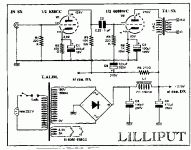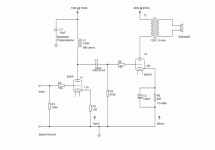Ciao,
I have a lot of 6N13S (6as7G) russian tubes, and a lot of 6N6P double triode; with these tubes I'm now testing few SE circuits and ideas.
Currently I'm thinking about THIS idea.
The topology will be a parafeed output stage, driven by a single 6N6P (CCS loaded).
To increase the output power I'd like to parallel two or more 6AS7G tubes; i already tried it in another prototype, but the result was not so good.
So, my idea is to place a dedicate CCS on top of each output tube, and then "parallel" them through the parafeed coupling capacitor to the output trafo.
Would it work?
I can provide a single negative voltage for the bias, or do I have to provide a separate bias for each tube?
I could even designe a servo bias circuit, that will keep all the output tubes at the same operating voltage.
I'm not sure on the result, because the output tubes are known to not to be very balanced, so I don't know what will happen "paralleling" them through the capacitors.
Your comments?
Ciao,
Giovanni
I have a lot of 6N13S (6as7G) russian tubes, and a lot of 6N6P double triode; with these tubes I'm now testing few SE circuits and ideas.
Currently I'm thinking about THIS idea.
The topology will be a parafeed output stage, driven by a single 6N6P (CCS loaded).
To increase the output power I'd like to parallel two or more 6AS7G tubes; i already tried it in another prototype, but the result was not so good.
So, my idea is to place a dedicate CCS on top of each output tube, and then "parallel" them through the parafeed coupling capacitor to the output trafo.
Would it work?
I can provide a single negative voltage for the bias, or do I have to provide a separate bias for each tube?
I could even designe a servo bias circuit, that will keep all the output tubes at the same operating voltage.
I'm not sure on the result, because the output tubes are known to not to be very balanced, so I don't know what will happen "paralleling" them through the capacitors.
Your comments?
Ciao,
Giovanni
The idea to use three separate CCS, one for each output triode, was indeed to help the matching: having (almost) the same current flowing in each triode, the operating point "should" be pratically the same...
And if, as said, I add a servo bias that keeps the anode voltage at the same level I "should" have three triodes working at the same voltage, with the same current.
Slight difference in operating curves should be irrelevant at this point, I think (I hope).
And if, as said, I add a servo bias that keeps the anode voltage at the same level I "should" have three triodes working at the same voltage, with the same current.
Slight difference in operating curves should be irrelevant at this point, I think (I hope).
Im planning to build a 6as7g SE amp too. Liliput Schematic look like a best choice to me.
Im thinking to parallel the two triode inside the same tube to get a bit more power.
what value/component should I change? what is the primary OPT value will be(625:8)?
Please advice.
Im thinking to parallel the two triode inside the same tube to get a bit more power.
what value/component should I change? what is the primary OPT value will be(625:8)?
Please advice.
Attachments
I see two potential trouble spots in your schematic..first your SS B+ will 'instantly' hit your cold tubes...might reek havoc, and you don't have a bleeder resistor on the B+.
Consider going tube rectifyed as it is gentler on your tubes.
____________________________________Rick..........
Consider going tube rectifyed as it is gentler on your tubes.
____________________________________Rick..........
I cannot download your link for some reason, but I think I get the idea.
The idea is excellent, I've had the same in my head for years, just haven't taken the time yet.
I've never had problems paralelling 6AS7s, but I've had to live with different idle currents thru each section. I really don't think it is such a big deal that some say. Just think of all those OTLs out there, do you really think they all have matched tubes? When the power is needed they will actually work together the way they are intended to do.
Btw, regarding 6AS7 ruggedness; for a couple of months I have thought my amp to be extra hot, but never took the time to open it up and check. Well, I finally did the other day, and the tubes were running at 28watts/triode!!! Thats 56watts per bulb! After readjusting the bias back to 12watts/triode, they still sound great. can't believe how rugged these tubes are. I have no idea how long they were run at 28watts, but it must be at least a couple of months. I've had the same tubes for years, and don't plan on changing them till they absolutely dont work.
The idea is excellent, I've had the same in my head for years, just haven't taken the time yet.
I've never had problems paralelling 6AS7s, but I've had to live with different idle currents thru each section. I really don't think it is such a big deal that some say. Just think of all those OTLs out there, do you really think they all have matched tubes? When the power is needed they will actually work together the way they are intended to do.
Btw, regarding 6AS7 ruggedness; for a couple of months I have thought my amp to be extra hot, but never took the time to open it up and check. Well, I finally did the other day, and the tubes were running at 28watts/triode!!! Thats 56watts per bulb! After readjusting the bias back to 12watts/triode, they still sound great. can't believe how rugged these tubes are. I have no idea how long they were run at 28watts, but it must be at least a couple of months. I've had the same tubes for years, and don't plan on changing them till they absolutely dont work.
The Lilliput wont drive the 6AS7 to full power, the preamp tube will clip first.
You'll need about +-125volts peak drive voltage and the latter circuit with the choke loaded driver will do that much better.
6AS7s may not be the most linear, but they are still the most under rated power triode out there. Perhaps the low rp and thus low winding ratio in the O.T. makes up for it's faults, b/c it certainly sounds great.
You'll need about +-125volts peak drive voltage and the latter circuit with the choke loaded driver will do that much better.
6AS7s may not be the most linear, but they are still the most under rated power triode out there. Perhaps the low rp and thus low winding ratio in the O.T. makes up for it's faults, b/c it certainly sounds great.
6AS7s may not be the most linear, but they are still the most under rated power triode out there. Perhaps the low rp and thus low winding ratio in the O.T. makes up for it's faults, b/c it certainly sounds great.
I love it - but in PP. My PP effort sounds very SE in characture.
Shoog
- Status
- This old topic is closed. If you want to reopen this topic, contact a moderator using the "Report Post" button.
- Home
- Amplifiers
- Tubes / Valves
- 6as7g Se

